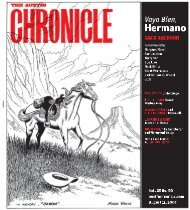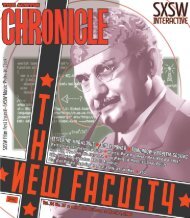Downloaded - The Austin Chronicle
Downloaded - The Austin Chronicle
Downloaded - The Austin Chronicle
- No tags were found...
You also want an ePaper? Increase the reach of your titles
YUMPU automatically turns print PDFs into web optimized ePapers that Google loves.
THE ARTS reviewsEXHIBITIONISMInvisible, Inc.Rollins Studio <strong>The</strong>atre at the Long Center,701 W. Riverside,www.hiddenroomtheatre.comThrough Jan. 20Running time: 1 hr., 30 min.<strong>The</strong> most important part of a magic trick isthe finish. You can dazzle ’em with showmanship,but if the final reveal doesn’t deliver, thetrick falls flat. Beth Burns, director of HiddenRoom <strong>The</strong>atre’s Invisible, Inc. – the worldpremiere of a new script by playwright PaulMenzer – seems very conscious of this fact.<strong>The</strong> play is an exercise in stakes-raising, teasingout its plot elements slowly and lettingthe story unfold at a deliberate pace. It balancesthe setup/punch line style repartee ofa screwball comedy with onstage magic tricksand moments of real gravity as it unfolds itsnoir mystery. And when it comes time for thebig reveal, it pays off the premise. Voila!Invisible, Inc. is the name both of the playand the magician’s troupe the play follows.Led by Sebastian Topflyte (Robert Matney),Invisible, Inc.’s team of tricksters – comprisedof the behind-the-scenes Doc Isoceles (ToddKassens) and Question Mark (LondonerLaurence Pears, returning to the <strong>Austin</strong> stageafter a show-stealing appearance in HiddenRoom’s Rose Rage), and Topflyte’s stage assistant,Ladyfingers (Liz Fisher) – are the hottestthing in Prohibition-era New York stage magic.That doesn’t sit well with aspiring magicianCord McCade (Joseph Garlock), whose downtown,undershirt-and-blue-jeans approach tostagecraft offers a more visceral take on theillusory arts than Topflyte’s tux, top hat, andtails. When a detective stops by the Invisible,Inc. office to inform Topflyte that his niece hasdisappeared at McCade’s show, the conflictbetween the two stops being one-sided. <strong>The</strong>magicians square off against each other asTopflyte’s team seeks the girl, and McCadeattempts to turn Ladyfingers to his own side.<strong>The</strong> play puts a significant load on theshoulders of Matney, who has to be by turnsPrestidigitation agitation: robert Matney(l) and Joseph Garlock as the feudingmagicians in Invisible, Inc.oafish and self-obsessed, capable of sellingnuanced drama, and able to pull off actualstage magic for an up-close audience, buthe’s more than up to the challenge. With somuch plot and trickery to get through, thereisn’t much time for character moments – andMatney gets the best of those – but Garlockdeserves mention for the intensity he bringsto McCade, balancing a palpable menacewith a performer’s charm, while Fisher’seasy chemistry with her male co-starsmakes her compelling.Ultimately, though, Invisible, Inc. is morethan just a well-acted performance of a tightlyplotted mystery, and this is where Burnsdistinguishes herself: It’s both a play aboutmagic and a performance of magic. Thatgoes beyond Matney and Garlock’s tricks,which are impressive on their own: <strong>The</strong> entireproduction is built around little pieces ofmagic – from the music provided by the playerpiano (reproducing a performance by GrahamReynolds) to the actual, onstage gunshots –and culminates in a reveal that pays off themystery the play has set up, just the way agood trick must. Voila. – Dan SolomonC o u r t e s y o f D a n i e l B r o C kC o u r t e s y o f t h e V o r t e xElizabeth: Heart of a King<strong>The</strong> Vortex, 2307 Manor Rd., 478-5282www.vortexrep.orgThrough Jan. 26Running time: 2 hr., 30 min.To the editors of the Wikipedia page“Cultural depictions of Queen Elizabeth Iof England”: Please add three more starsto the firmament that boasts such twinklersas Sarah Bernhardt, Bette Davis,and Judi Dench. Elizabeth may have livedover four centuries ago, but that fiery redheadis excellently revived this month withpowerful performances from the threevirgin queens of Lorella Loftus’ ambitiousnew bio-play, Elizabeth: Heart of a King.Drawing from the robust Tudor historicalfiction genre, the play is a life-sizedtriptych that features Angela Loftus (theplaywright’s daughter) as Lady Elizabeth;Lorella Loftus as middle-aged ElizabethRegina; and Jennifer Underwood asGloriana, her majesty in the winter years.Loftus uses short vignettes to chart a<strong>The</strong> three faces of e.: (l-r) Angela Loftus, Lorella Loftus,and Jennifer Underwoodcourse through Elizabeth’s life, mostlyfocusing on (and imagining details about)the old maid’s fraught love affairs, thoughthe audience is also treated to a buffet ofcharacters courtesy of the flexible ensemblecast, including papa Henry VIII, MarysTudor and Queen of Scots, and advisorWilliam Cecil. Individually, the scenes aretight and engaging, but they eventuallyfeel like dots in a pointillist painting thatnever quite comes into focus; without amajor dramatic arc, the play quickly losesforward momentum.Eight actors, most of whom are seatedonstage, play all the characters who driftthrough Elizabeth’s life, through doublingnot unlike what the queen might haveseen onstage in her day. (Nikki Zookmakes a particularly stunning turn as bothMarys.) Director Karen Jambon uses theVortex’s small stage effectively, but inconsistenciesin the actors’ accents occasionallycreate disruptive moments.For an Elizabethan period drama, thedesign is remarkably stark; you won’tfind lace ruffs or gold leaf facades here.Ann Marie Gordon’s simple set andPam Fletcher Friday’s monochromaticcostumes create a blank slate for thevignettes. <strong>The</strong> versatile cast, PatrickAnthony’s moody lighting, and a few wellplacedaccessories are all we need toimagine the court’s pomp. Though DavidDeMaris’ Renaissance music adds to theillusion, his video design –images of Elizabeth, rosegardens, and Tudor architecture– is distracting.But Elizabeth’s greateststrength lies in theactresses who share thetitular role. Each bringssomething different to thepart, dramatizing the evolutionwe all experience aswe age. <strong>The</strong> younger Loftus’pre-coronation Elizabeth issweet and vulnerable, butreveals her stubbornnessin raging soliloquies; theelder Loftus, as charismatic queen, isat one moment cheerful, then instantlyirate; and Underwood carefully descendsfrom headstrong monarch to tired oldwoman. <strong>The</strong> Elizabeths are united under arecurring quandary: Is it possible to be awoman and a queen? Though she “earnsher place among the glorious” in the end,it seems that Elizabeth ranked the love ofher people over the love of men.– Jillian OwensYefimBronfmanC o u r t e s y o f D a r i o a C o s t a<strong>Austin</strong> SymphonyOrchestra WithYefim BronfmanRollins Studio <strong>The</strong>atre atthe Long Center, 701 W. RiversideJan. 11When you’re going to venture intoa land of wide-ranging and rigorousterrain, you want to be withsomeone who knows the territory.Johannes Brahms’ Piano ConcertoNo. 1, though written when thecomposer was still in his early 20sand feeling his way through symphoniccomposition, is an expansivecountry in which you traversedense rain forests, placid lakes,vast savannas, rocky coastlinespounded by surf, river valleys, sierras,snowfields, and much more– so much, in fact, that it’s easy toget lost in it. But with the estimableYefim Bronfman at the keyboard,you not only know where you areevery step of the way, you canappreciate in full each sweepinglandscape and panoramic vista.Bronfman is like the guide whohas traveled so extensively througha region that he knows every inchintimately, as he demonstratedto the crowd’s delight during hisperformance of the concerto withthe <strong>Austin</strong> Symphony last week. Inevery moment of every movement,every shift in the drama – and ohmy, is there ever a wealth of dramapacked into this piece – Bronfmandisplayed a masterful command ofthe material: famously pummelingthe keys in the first movement’sstormiest flashes, then lightlydancing his way across them in itsjubilant runs and crisply executingits exacting trills; sounding outwith deep sensitivity and delicacythe reflective Adagio; and bringinga resolute vigor to the ever-morechallenging Rondo that seemed togather more energy and purposewith each new demand from thescore. While the work leaves ampleroom for bluster and romantic sentimentality,Bronfman never so muchas glanced in that direction. Hisplaying was certainly forceful andemotional, but it was measured,carefully calibrated to the music,coming from a place of clear-eyedcomprehension rather than recklesspassion or artistic self-indulgence.On the podium, ASO conductorPeter Bay led the orchestra withcomparable restraint. He had hisensemble play the intimate travelingcompanion to Bronfman’s piano,sometimes chiding it, sometimessoothing it, raising its voice in dissensionor assent, quietly grumblingin the background or offering tendersupport, always with fullness offeeling but never more or less thanexpressed by the soloist. <strong>The</strong>ir partnershipwas held in admirable balance,each playing off of and feedingthe other. Together, Bronfmanand ASO provided a spirited, exhilaratingtour of what seemed like halfthe globe. – Robert Faires30 T H E A U S T I N C H R O N I C L E JANUARY 18, 2013 a u s t i n c h r o n i c l e . c o m
















